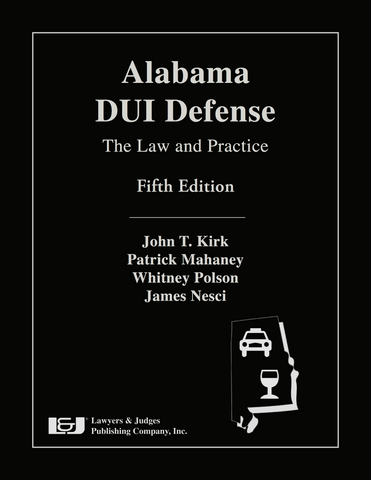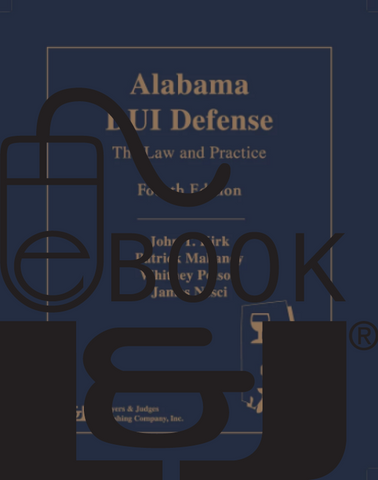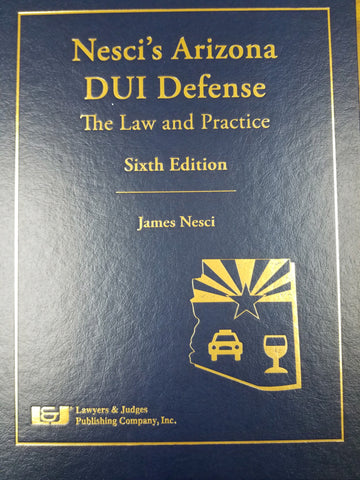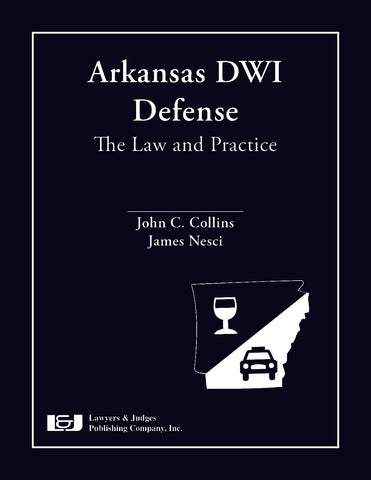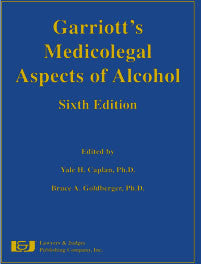
Garriott's Medicolegal Aspects of Alcohol, Sixth Edition PdF Ebook
-
Edited by: Yale H. Caplan Ph.D., Bruce A. Goldberger Ph.D. Contributions by: Erik H. Aguayo B.S., Mary Anderson J.D., William H. Anderson Ph.D., Fred S. Apple Ph.D., Lindsay A.L. Bazydlo Ph.D., Randall Beaty B.S., Roger L. Bertholf Ph.D., Dennis V. Canfield Ph.D., Kurt M. Dubowski Ph.D., LL.D., Kenneth E. Ferslew Ph.D., Robert B. Forney Jr., Ph.D., Rod G. Gullberg M.S., Patrick Harding B.S., Graham R. Jones Ph.D., Loralie J. Langman Ph.D., Barry Levine Ph.D., Laura Liddicoat B.S., Bill H. McAnalley Ph.D., Robert A. Middleberg Ph.D., Herbert Moskowitz Ph.D., James Nesci J.D., James T. O'Donnell Pharm.D., James J. O’Donnell III, Ph.D., Vikram Palamalai Ph.D., Joseph Turner B.S., M.S., Jarrad R. Wagner Ph.D., J. Robert Zettl B.S., MPA
- ISBN 10: 1-936360-88-8
-
ISBN 13: 978-1-936360-88-8
-
Copyright Date Ed: September 29, 2014
-
Pages: 720
-
Binding Information: PdF Ebook
- Size: 8.5 X 11 Inches (US)
Now available in its Sixth Edition as a PdF, Garriott's Medicolegal Aspects of Alcohol is the hands-down indispensable textbook for forensic toxicology and for anyone involved with the medicolegal aspects of alcohol.
Alcohol-related litigation typically pertains to arrests of drinking drivers, also includes industrial accidents, public transport accidents, and violent crimes. The medicolegal aspects of alcohol are complex topics because so many different components are present in alcohol-related criminal and civil cases.
Forensic alcohol analysis is the most frequently performed of all forensic laboratory tests. It is extremely important that alcohol analyses be performed accurately and correctly and that the results are properly interpreted. Forensic toxicologists and pathologists are often called on to interpret the alcohol concentrations found in the specimens. Often, the results are deemed meaningless because samples are mishandled, equipment is incorrectly calibrated, or the results are incorrectly reported.
This Sixth revised edition is designed to continue to provide you with up-to-date and authoritative information on alcohol in all aspects of its involvement in the forensic sciences. The original authors have provided updated science and information in their topic areas, and new authors with special expertise have been brought on board. All topics in the original book have been revised and expanded and new sections including standardized field sobriety testing and uncertainty in blood and breath alcohol measurements have been added.
The wealth of information presented in this new sixth edition makes it an invaluable resource when investigating and litigating cases involving alcohol.
Table of Contents
Foreword
Preface
Chapter 1. Chemistry of Alcoholic Beverages
Synopsis
1.1 Introduction
1.2 Description and History of Common Alcoholic Beverages
A. Fermented Alcoholic Beverages
B. Distilled Alcoholic Beverages
C. The Effects of Aging (Maturation)
1.3 Fermentation
A. Yeasts
B. Bacterial Contamination
1.4 Nutritional Value of Alcoholic Beverages
A. Carbohydrates
B. Proteins
C. Fats
D. Vitamins and Minerals
1.5 Antimicrobial Properties of Alcoholic Beverages
1.6 Cancer and Alcohol
1.7 Ethyl Alcohol Content
1.8 Congeners
1.9 Classification of Congeners
A. Volatile Congeners
B. Alcohols
C. Aldehydes
D. Esters
E. Alcohols, Aldehydes, and Esters
F. Common Acids
G. Ketones
H. Phenols
1.10 Vasoactive Congeners
A. Tyramine
B. Histamines
C. Ethanol and Grain Components
D. Toxic Metals
1.11 Congeners from Spices and Herbs
1.12 Semivolatile Congeners
References
Chapter 2. Pharmacology and Toxicology of Alcohol
2.1 Introduction
2.2 Skin
2.3 Gastrointestinal Tract
2.4 Cardiovascular System
2.5 Liver
2.6 Kidneys
2.7 Endocrine System
2.8 Teratogenicity
2.9 Central Nervous System
A. Chronic CNS Effects
B. Blackout
2.10 Impairment of Specific Functions Related to Driving Ability
A. Vision
B. Auditory discrimination
C. Other sensory effects
D. Reaction time
E. Review of Research On Alcohol Impairment of Driving/Piloting Skills
1. Motor vehicle
2. Motorcycle
3. Aviation
2.11 Effects of Alcohol in Combination with Other Drugs
A. Acetaminophen/Salicylate
B. Amphetamines
C. Antidepressants
D. Barbiturates
E. Benzodiazepines
F. Caffeine
G. Cocaine
H. Histamine2-Receptor Antagonists
I. Marijuana
J. Opioids
2.12 Antagonists to Alcohol and Pharmacotherapeutic Agents for Alcoholism
A. Disulfiram (Antabuse) and Other Acetaldehyde Antagonists
B. Narcotic Antagonists
C. Acamprosate
D. Other drugs
2.13 Effects on Children and Adolescents
2.14 Tolerance and Dependence
References
Chapter 3. Disposition and Fate of Ethanol in the Body
3.1 Introduction
3.2 Fate of Drugs in the Body
3.3 Forensic Science Aspects of Alcohol
3.4 Ethyl Alcohol
A. Chemistry
B. Amounts of Alcohol Consumed
C. Alcoholic Beverages
D. Analysis of Ethanol in Body Fluids
E. Reporting Blood Alcohol Concentration
F. Water Content of Biofluids
3.5 Alcohol in the Body
A. Endogenous Ethanol
B. Absorption
C. Distribution
D. Metabolism
3.6 Pharmacokinetics of Ethanol
A. First-Order Kinetics
B. Zero-Order Kinetics
C. Non-Linear Saturation Kinetics
D. The Widmark Equation
E. Updating the Widmark Equation
F. Pharmacokinetics of Ethanol Metabolites
G. Physiological Range of Ethanol Elimination Rates
3.7 Characteristics of Blood-Alcohol Curves
A. Ingestion of Alcohol on an Empty Stomach
B. Inter- and Intra-Individual Variations
C. Factors Influencing Cmax and tmax
D. Effects of Food in the Stomach
E. Gender Differences
F. Repetitive Drinking
G. Effect of Age on Widmark Parameters
H. Blood-Alcohol Profiles after Drinking Beer
I. Retrograde Extrapolation
J. Massive Ingestion of Alcohol under Real-World Conditions
K. Effects of Drugs on Metabolism of Ethanol
L. Elimination Rates Ethanol in Alcoholics During Detoxification
M. Ethanol Metabolism in Pathological States
N. Short-Term Fluctuations in Blood-Alcohol Profiles
O. Intravenous vs. Oral Route of Ethanol Administration
3.8 Ethanol in Body Fluids and Tissues
A. Water Content of Specimens
B. Urine
C. Breath
D. Saliva
E. Cerebrospinal Fluid (CSF)
F. Tears
G. Sweat
H. Mother’s Milk
I. Brain and Body Organs
J. Vitreous Humor
K. Hair
3.9 Concluding Remarks
References
Chapter 4. Biomarkers of Acute and Chronic Alcohol Ingestion
4.1 Introduction
4.2 Alcohol Toxicity
A. Physical and Sociological Consequences of Alcohol Abuse
B. Alcohol-Related Impairment
C. Blood Alcohol Concentration
D. Alcohol Hangover
E. Alcohol-Related Liver Disease
4.3 Quantity of Alcohol Consumed
A. Definition of a Standard Drink
4.4 Alcohol in the Body
A. Absorption from the Gut
B. Distribution in All Body Fluids and Tissues
C. Elimination via Excretion and Metabolism
D. Oxidative Metabolism of Ethanol
E. Metabolic Consequences
4.5 Evaluating Drinking Habits
A. Questionnaires and Self-Reports
B. Biochemical Markers of Alcohol Problems
C. Markers of Acute Alcohol Ingestion
D. Methanol as a marker of ethanol use
E. Urinary Metabolites of Serotonin
F. Non-Oxidative Metabolites of Ethanol
4.6 Long Term Markers of Ethanol Abuse
A. Carbohydrate Deficient Transferrin (CDT)
B. Gamma-glutamyltransferase (GGT)
C. Mean Corpuscular Volume (MCV)
D. Other Biomarkers of Excessive Drinking
4.7 Forensic Applications of Biomarkers
A. Postmortem Toxicology
B. Control of Abstinence
C. Alcohol Biomarkers in Hair
D. Traffic Medicine
4.8 Efficacy of Diagnostic Screening Tests
A. Sensitivity and Specificity
B. Positive and Negative Predictive Values
4.9 Conclusion
References
Chapter 5. Specimen Considerations for Alcohol Testing
5.1 Introduction
5.2 Blood
A. General Considerations
B. Antemortem Sources of Blood Specimens
C. Postmortem Sources of Blood Specimens
5.3 Serum and Plasma
5.4 Urine
5.5 Saliva (Oral Fluid)
5.6 Brain and Cerebrospinal Fluid
5.7 Vitreous Humor
5.8 Bile
5.9 Skeletal Muscle
5.10 Intracerebral Blood Clots
5.11 Gastric Contents
5.12 Other Specimens
5.13 Considerations for Interpretation Postmortem Specimens
A. Interfering Volatile Substances
B. Effects of Embalming
C. Diffusion of Alcohol
D. Postmortem Decomposition
E. Antemortem Dilution
References
Chapter 6. Physiological Basis and Practice of Breath Alcohol Determination
6.1 Introduction
6.2 Chemistry of Ethyl Alcohol
6.3 Impairment by Ethyl Alcohol
6.4 Alcohol in the Body
A. Pharmacokinetics
B. Absorption
C. Distribution
D. Elimination
E. Circulatory System
F. Pulmonary System
6.5 Blood Breath Relationships
A. General
B. Henry’s Law
C. Fick’s Law
6.6 Why Breath Tests of Blood-Alcohol Don’t Work
6.7 Why Breath Tests of Blood-Alcohol Do Work
6.8 Breath Temperature
6.9 Elements of a Forensic Breath Test Program
6.10 Alcohol Test Programs
6.11 Recommendations of the National Safety Council - Committee on Alcohol and Other Drugs (now the NSC Alcohol and Drug Impairment Division)
6.12 Conclusion
References
Chapter 7. Methods for Breath Alcohol Testing
7.1 Introduction
7.2 Sampling Breath for Alcohol Analysis
A. End-expiratory Breath is the Desired Specimen
B. Residual Mouth Alcohol
C. Condensation Losses, Carryover
D. Additional Steps
7.3 Breath Alcohol Testing Instrumentation
A. Testing Instruments
1. Passive alcohol sensor (PAS)
2. Screening device
3. Ignition interlock device
4. Evidential breath tester
B. Calibrating Units
7.4 Requirements for Evidential Breath Testing
A. General
B. Data Collection
C. Maintaining Reliability
D. Federal Specifications
7.5 Challenges to the Validity of Breath Alcohol Results
A. Rules, Regulations and Documentation
B. Specificity
C. Residual Mouth Alcohol
D. Blood:Breath Alcohol Ratio
E. Radio Frequency Interference
F. Instrument Variability
7.6 Breath Alcohol Testing Instruments
A. Infrared Spectroscopy
1. Intoxilyzer® 8000
2. Intoxilyzer® 9000
3. Intox DMT
B. Electrochemical Oxidation/Fuel Cell
1. Intox EC/IR II
2. RBT IV
3. Alco-Sensor FST®
4. Alco-Sensor® VXL
5. Intoxilyzer® S-D5
6. Alcotest® 6510, Alcotest® 6810
7. Alcotest® 7510, Alcotest® 8610
8. Lifeloc FC20, FC20BT
C. Dual Detector: Infrared/Fuel Cell
1. Alcotest 9510
Trademarks
Endnotes
References
Chapter 8. Methods for Biological Specimen Alcohol Testing
8.1 Introduction
8.2 Chemical Methods (Colorimetric)
8.3 Biochemical Methods (Enzymatic)
8.4 Gas Chromatographic Methods
A. Extraction Techniques
B. Distillation Techniques
C. Direct Injection Techniques
D. Headspace Sampling
8.5 Gas Chromatography-Mass Spectrometry
8.6 Analysis of Volatiles- General Considerations
A. Specimen preparation
B. Calibrators and controls
C. Analysis
D. Assay validation
E. Proficiency testing
References
Endnotes
Chapter 9. Quality Assurance for Biological Specimen Alcohol Measurements
9.1 Introduction
9.2 Pre-testing Issues 27
A. Collection Tubes and Directions
9.3 The Laboratory
A. Personnel
9.4 Testing
A. Specimen Suitability for Testing
B. Analytical Methods—Calibration
C. Validation and Approaches to Calibration
D. Quality Control and Matrix Validation
E. Batch Analysis
F. Quality Control
G. Acceptance Criteria
H. Monitoring Quality Control Performance
I. Instrument Maintenance
J. Proficiency Tests
9.5 Post Testing
A. Reporting
B. Uncertainty
C. Records and Specimen Retention
References and Bibliography
Reference Materials and Controls
Proficiency Testing Programs
Chapter 10. Collection and Storage of Specimens for Alcohol Testing
10.1 Introduction
10.2 Loss of Ethanol
A. Evaporation
B. Oxidation
C. Microbial Action
D. Recommendations to Prevent Ethanol Loss
10.3 Ethanol Gain
A. Physical Contamination
B. Production of Ethanol by Microorganisms
C. Recognition of Postmortem Generation of Alcohol
10.4 Preservation of Biological Specimens
A. Collection of Specimens from Living Subjects
B. Collection of Postmortem Specimens
10.5 Conclusions
References
Chapter 11. Alcohol Effects and Driving Impairment
11.1 Introduction
11.2 The Presence of Alcohol in Drivers
11.3 Alcohol and Accidents
11.4 Single-Vehicle Collisions
11.5 Measures of Intoxication
11.6 Driving Abilities Impaired by Alcohol
11.7 Rate of Alcohol Consumption
11.8 Alcohol and Fatigue
11.9 Alcohol and Memory
11.10 Alcohol and Aggression
11.11 Alcohol and Degree of Injury
Endnote
References
Chapter 12. Standardized Field Sobriety Testing
12.1 Role of Standardized Field Sobriety Testing in Impaired Driving Enforcement
12.2 Role of the National Highway Traffic Safety Administration (NHTSA)
12.3 Standardized Field Sobriety Testing
A. Components of SFST
References
Chapter 13. Epidemiologic Basis of Alcohol-Induced Psychomotor Performance Impairment
13.1 Introduction
13.2 Establishing the Relationship
13.3 Working Through The Ambiguities
13.4 Chronological Development of Epidemiology Database
13.5 North American Studies
13.6 International Studies
13.7 Have Our Actions From Studying Epidemiological Studies Produced Effects?
13.8 Summary
13.9 Dedication
13.10 Acknowledgements
References
Chapter 14. Experimental Basis of Alcohol-Induced Psychomotor Performance Impairment
14.1 Introduction
14.2 Observation and Measurement of Alcohol Performance Impairment
14.3 Psychomotor Performance Testing
A. Driving Simulators
B. Roadside Testing or Field Sobriety Testing (FST)
C. Impairment When BACs Are Between 0.00–0.079 g/dL
D. Impairment at BAC ≥ 0.10 g/dL
E. Alcohol and Drug Interactions
14.4 Application of Performance Information to DUI-DWI
14.5 Conclusions
14.6 Dedication
14.7 Acknowledgement
References
Chapter 15. Physical Manifestation of Alcohol Intoxication
15.1 Introduction
15.2 Legal Statutes
15.3 Case Presentation
15.4 Blood Alcohol Concentration and Lack Of Visible or Obvious Intoxication
15.5 Conclusion
References
Chapter 16. Clinical Aspects of Alcohol Testing
16.1 Introduction
16.2 Pre-analytical variables
16.3 Clinical Considerations
A. The Patient
B. Laboratory-based Patient Assessment
C. Hypoglycemia
D. Alcoholic Ketoacidosis (AKA)
E. Thiamine Deficiency
F. Anion Gap
G. Osmol Gap
16.4 Measurement of Alcohol
16.5 Conclusions
References
Chapter 17. Alcohol Testing in the Workplace
17.1 Introduction
A. Industries and Workplaces Affected by Alcohol
B. Regulated and Non-Regulated Testing for Alcohol
17.2 Some Legal Aspects of Alcohol Testing in the Workplace
A. In General
B. The Regulatory Environment
17.3 Features of Alcohol Testing in the Workplace
A. Special Features of Workplace Testing for Alcohol
B. Purpose of Alcohol Testing in the Workplace
C. Alcohol Testing Categories and Indications for Alcohol Testing
D. Reasonable Suspicion Testing
E. Testing Locations: On-Site versus Off-Site
17.4 Alcohol Testing Regulated by U.S. Department of Transportation
A. Prohibited Conduct
B. Required Alcohol Testing
C. Features of Alcohol Testing Under DOT Regulations
D. Significance, Interpretation and Consequences of Test Results
E. Quality Assurance Aspects
F. Statutory and Regulatory Changes in Transportation Workplace Alcohol Testing
17.5 Testing Technology and Practices
A. Analysis and Specimens
B. Testing in the DOT Program
C. Screening Tests
D. Evidentiary Tests
E. Calibrating Devices
F. Training Requirements
G. Testing in the Nuclear Regulatory Commission Programs
17.6 Interpretation of Alcohol Test Results
A. Acute Effects of Alcohol
B. Combined Effects of Alcohol and Other Drugs
C. Hangover Effects of Alcohol
D. Abstention Period
17.7 Acknowledgment
References
Endnotes
Chapter 18. Statistical Applications in Forensic Toxicology
18.1 Basic Introductory Statistics
18.2 Samples, Populations and Distributions
A. Descriptive Statistics
B. Inferential Statistics
C. Regression Analysis
D. Non-Parametric Statistical Analyses
18.3 Transformations
18.4 Bayesian Statistics
18.5 Sample Size
18.6 Duplicate Test Agreement Criteria
A. Proficiency Testing
18.7 Widmark’s Equation
18.8 Blood/Breath Alcohol Ratios
18.9 Experimental Design
18.10 Communicating Statistical/Numerical Information
18.11 Conclusions
Glossary of Terms
Endnotes
Practice Problems
Appendix
Chapter 19. Uncertainty in Blood and Breath Alcohol Measurements
19.1 Introduction
19.2 Defining Measurement Uncertainty
19.3 Basic Principles of Measurement
A. Properties of Measurement
B. Factors Contributing to Measurement Uncertainty
C. General Approaches to Measurement Uncertainty
D. General Steps for Estimating Measurement Uncertainty
Example 1: Breath Alcohol Measurement Uncertainty
Example 2: Blood Alcohol Measurement Uncertainty
E. Treatment of Bias
F. Other Approaches to Estimating Measurement Uncertainty
1. Total Allowable Error
2. Proficiency Testing
3. Guard Band Approach
4. Monte Carlo Approach
19.4 Conclusions
Endnotes
Chapter 20. Application of ISO Standards to the Measurement of Alcohol
20.1 The State of Forensic Science
A. The National Academy of Sciences Report
B. Forensic Toxicology
20.2 Credentialing the Organization and the Practitioner
A. Accreditation
B. Certification
20.3 Standardization: A Basis for Accreditation
A. International Organization for Standardization
B. Standardization Economies
C. ISO Standards
D. Early Laboratory Standard Development
E. Forensic Toxicology Laboratories and International Standards
F. Amplification of the ISO Standard
20.4 Accrediting the Accreditors
A. Standards for the Certifying and Accrediting Boards
B. International Recognition of Accrediting Bodies
20.5 Quality Management
A. The Beginnings of Quality
B. Quality Assurance
20.6 The Path to Accrediting a Laboratory
A. Planning Ahead
B. The Quality Manual
C. The Quality Management System
20.7 The National Commission on Forensic Science
Chapter 21. Prosecution of the Alcohol-Impaired Driving Case
21.1 Introduction
21.2 The Big Picture
21.3 Complexity of Prosecuting the Impaired Driving Case
21.4 The Alcohol-Impaired Driving Case
21.5 Factual Witnesses
21.6 Expert Witnesses
21.7 Preparing for Court Prior to Being Called to Trial
References
Endnotes
Chapter 22. Defense of Driving Under the Influence Cases
22.1 Introduction
22.2 Driving and Field Sobriety Testing
A. Overview: National Highway Traffic Safety Administration
B. Driving Behavior
C. Standardized Field Sobriety Testing (SFST) Validation Studies
D. Legal Analysis and Summary of the SFST Validation Studies
E. Final Thoughts on the Standardized Field Sobriety Test Battery
22.3 Drug Recognition Evaluation
A. Overview
B. DRE Statutory Law
C. DRE Case law
D. The 12-Step Protocol
E. Deconstruction and Analysis of the 12-Step Protocol
F. Effects of Various Drugs
G. Drug Evaluation and Classification Protocol (DECP)
22.4 Chemical Testing
A. Preliminary Breath Testing/Preliminary Alcohol Screening
B. Safeguards
C. Commonly Used PBT Devices
D. Evidential Breath Testing
E. Breath Testing: Methods of Attack
F. Calibration
G. Blood Testing: Methods of Attack from the Vein to the Lab
H. Headspace Gas Chromatography
I. Secondary Blood Testing
22.5 BAC Calculations for Attorneys
A. Determining the One-Drink Potential
B. Elimination and Retrograde Extrapolation
C. White’s Retrograde Extrapolation
D. Partition Ratio Conversions
E. Unit Conversions
References
Chapter 23. Legal Proceedings and the Expert Witness
23.1 Introduction
23.2 The Need for Expert Witnesses
23.3 What is an Expert Witness?
23.4 Financial Issues
23.5 The Law of Evidence
A. Overview
B. Burden of Proof
23.6 Degree of Evidence Required to Sustain the Burden of Proof
A. Beyond a Reasonable Doubt
B. Preponderance of the Evidence
C. Clear and Convincing Evidence
23.7 Reconciling Statistical Confidence Levels and Legal Proof
23.8 Categories of Evidence
23.9 Expert Reports
23.10 Diagrams and Demonstrative Evidence
23.11 The Threshold Question of Admissibility
23.12 Discovery and the Expert Witness
A. The Discovery Process
B. If You Are Contacted by the Opposing Attorney
C. Informal Interviews
D. Written Interrogatories
E. Affidavits
F. The Subpoena
G. If You Are Subpoenaed
H. The Deposition
I. Depositions Are Used For:
23.13 Elements of Testimony
A. Voir Dire
B. Direct Examination or Examination in Chief
C. Cross-Examination
D. Re-Direct
E. Credibility and Communication
F. Credibility Determinations and the Jury
G. Credentials and Your Testimony
23.14 Keys to Effective Testimony
A. Before You Get to the Witness Stand
B. In the Courtroom
C. On the Stand
D. The “Don’ts”
E. Final Pointers
23.15 The Nature of Litigation
A. Hurry Up and Wait
B. Variables in Litigation
Selected Reading
Chapter 24. Alcohol and Civil Litigation
24.1 Introduction
24.2 Alcohol Injury Epidemiology
24.3 Alcohol Intoxication Effects in Litigation 65
24.4 Differences between Civil litigation involving alcohol from criminal litigation/DUI
24.5 Settings for Alcohol Related Litigation
A. Employment
24.6 Police Activities
A. Pursuit
B. Excessive Force
24.7 Motor Vehicle Collisions
A. Vehicle/Vehicle
B. Motorcycle cases
C. Boating
24.8 Alcohol and Fall Risk
A. Stairs – no alcohol test – fall on Bar Stairs
B. Stairs – residential stairs fall
24.9 Family Law – Biomarkers for Alcohol
24.10 Conclusion
References
About the Authors
Index

